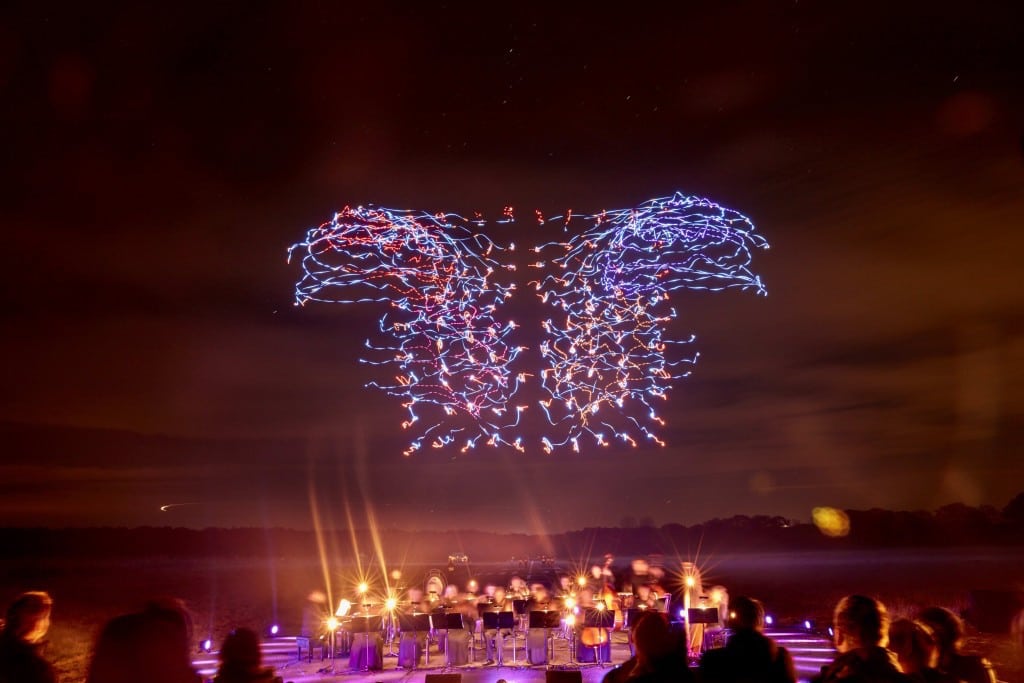How Intel's CEO Set a New Standard For Conference Keynote Speeches

Skift Take
BMX bikers wearing Intel's tiny Curie chips did backflips over Intel CEO Brian Krzanich's head during his keynote presentation at the Computer Electronics Show in Las Vegas last week, but that wasn't the best part.
Nor was the self-guided drone with collision-avoidance sensor technology that weaved itself through a forest of trees set up on stage, while following and filming a moving mountain biker.
The most compelling technology during Krzanich's presentation at CES 2016 was shown in a new video called "Drone 100" filmed recently over a German airfield at night.
Intel contracted Austrian-based Ars Electronica Futurelab to develop software to fly 100 illuminated drones in a tightly choreographed dance across a dark sky, with their lights synced to a live orchestra playing Beethoven's 5th symphony.
Krzanich's presentation did two things.
It set a new standard for experiential, tech-driven keynote speeches at conferences that every event organizer and C-suite executive should study. The digitally-infused live experiences and hybrid content interplay was how Intel was able to keep an audience engaged for one hour and 48 minutes.
It also portends a future where companies like Intel and Microsoft could potentially create an aura of pop culture consumer cool factor around their brands, which they've never really enjoyed in the past beyond the realm of the tech community.
That's no small thing. If drones and robotics, wearable fashion, virtual and augmented reality, and the sentient Internet of Things are the language of the future, then those companies delivering the best products will become the kingpins of cool for Gen Z. Somewhat like Apple did with personal computing, mobility and music for Gen X and millennials.
It also serves as a reminder for the power of live conferences and events over online communication.
The Rise of Experiential Tech
The full video of Krzanich's keynote is above, with the Drone 100 video kicking off the tech product announcements of the presentation around the 14:30 mark.
The rest of the talk focused on live experiences and a pervasive theme of technology in action, versus just the technology itself. That emphasis on showing what new tech can do and deliver in a live real-time environment is going to be a growing trend in conference design moving forward.
"We believe we've entering a new era of consumer technology, where consumers are choosing experiences over products," said Krzanich. "Products that are purely based on the newest technology or feature, those are the way of the past. The technology that enables the new experience, that's the product that will be successful in the future."
The three trends, he added, prioritizing technology experience are: smart and connected tech, the "sensification" or self-perception of tech, and tech as an immediate and visceral extension of the user.
Krzanich then shifted gears into providing specific context around a series of live tech experiences on stage, some of which are described following this "Making of Drone 100" video.
The actual flight starts at the 3:37 mark.
1. Gaming is now a spectator sport with the rise of e-sports tournaments and crowdsourced game development.
The Intel CEO suggested that game tech has become so immersive and sensory that it's not much different than other sports, which seems like a big red flag around growing obesity and complacence in America, but that's another story.
"E-sports have become a full-on, highly immersive, and truly social experience," explained Stephanie Harvey, an Intel-sponsored pro gamer.
During the keynote, she played a video game of Rainbow Six Siege on stage (22:20) while live-streaming her progress on the Twitch network where anyone could watch her play remotely.
That social experience aspect of modern gaming provides a lot of potential for both event planners and sponsors around next generation gamification at conferences.
2. Introduced at CES 2015, Intel's Curie chip is described as a full computer system that's the size of a button.
The company and its partners are now using Curie technology for wearables to provide real time data feedback of who or whatever is wearing the chip during live action events.
To illustrate that on stag, the Intel crew set up a series of BMX bike jumps. As the bikers flew through the air, with Curie chips attached to their clothing and bikes, the stage backdrop screen showed different data in real time detailing the bikers speed, height and other metrics.
Meaning, an audience now has a way to compare contestants with data in a second screen environment, live or virtual, to augment the spectator experience.
ESPN president John Skipper then showed up on stage to describe how the new Intel technology will be used for the first time at a public sporting event at X Games Aspen beginning January 28.
"This [young] audience wants data and information; they want excitement," said Skipper. He then described how ESPN was the first to use GoPro and drones in live sports broadcasts, so this new Curie data capture and delivery tech is basically an extension of that.
Following that, Krzanich showed a video (37:38 mark) of snowboarders discussing the value of augmented data for the audience, carrying on the keynote's marriage of live and high-impact digital content.
Then Andy Gall, CTO of Red Bull Media House, came out to show a new campaign filmed with a parkour athlete wearing a Curie chip.
3. Krzanich introduced what he called the world's first smart drone with Intel's "RealSense" self-navigable tech for the consumer market.
The collision-avoidance camera and software system inside the drone makes the device self-aware with the ability to perceive a changing outdoor environment and react to it in real time.
Up until now, the "follow me" drone technology that tracks a wearable transmitter attached to a moving target was only available with collision-avoidance capability in commercial and military applications.
In the mock-up mountain bike course on stage, (46.25 mark) the drone followed a biker riding along a path from both behind him and in front as it navigated around trees, including one that collapsed just as the drone was approaching it.




